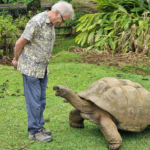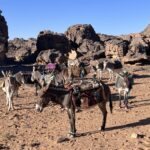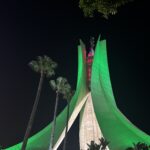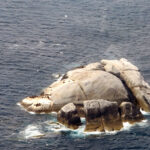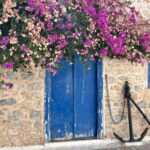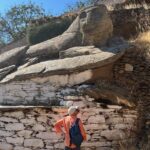Latest Posts:
Réunion – what’s Paris doing in the Indian Ocean?
Thursday, 6 November 2025
I’d not really thought about Réunion, until I was heading for Mauritius, but it’s only 200km to the west so why not pop over for a few days? Réunion is in fact much closer to Mauritius than Rodrigues, the second island of Mauritius. In area it’s slightly larger (2512 square km versus 2040) and in population it’s a bit smaller (900,000 versus 1.25 million). Geographically they’re very different, much of Mauritius is quite flat, with assorted scattered mountain peaks while Réunion is all mountain peak, as soon as you leave the coast you’re heading uphill. Around the northern tip of the island the mountains fall so abruptly into the ocean that the 12km New Coastal Road (Nouvelle route du Littoral) from the capital Saint-Denis is slung offshore and has been described as ‘the most expensive road in the world.’
Réunion, unlike Seychelles and Mauritius, which I visited en route to the island, is not an independent nation, it’s a French colony and indeed it feels like one. Everything about it is very French from the language (bring your French phrasebook), to the cars and motorcycles (lots of big Japanese, British and German superbikes, not so many little two-wheelers), to the numerous cafes, restaurants and bars. Great ice cream too, try l’Igloo Gelateria in Saint-Denis. The speed cameras are very French as well, I picked up a €90 speeding ticket for doing 56kph in a 50kph zone.
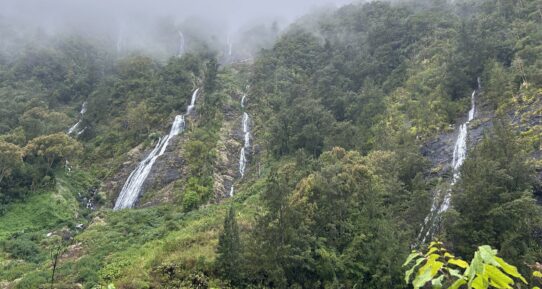 ▲ Drive east and then south from Saint-Denis, the capital and turn inland towards Salazie and you’re soon climbing a gorge into the central highlands, passing a regular cascade of waterfalls, particularly if it has been raining.
▲ Drive east and then south from Saint-Denis, the capital and turn inland towards Salazie and you’re soon climbing a gorge into the central highlands, passing a regular cascade of waterfalls, particularly if it has been raining.
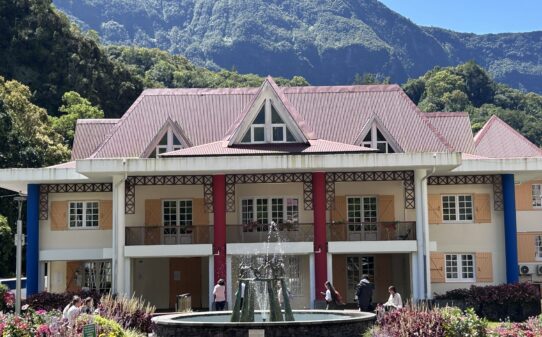 ▲ The Salazie Town Hall (Hotel de Ville) is a fine example of the Creole architecture Réunion is noted for.
▲ The Salazie Town Hall (Hotel de Ville) is a fine example of the Creole architecture Réunion is noted for.
 ▲ Hell-Bourg – continue uphill and you’ll arrive at Hell-Bourg, ‘one of the most beautiful villages in France’ according to the Lonely Planet Mauritius, Réunion & Seychelles guidebook. That’s a big claim, but there are certainly some very pretty Creole cottages in the village.
▲ Hell-Bourg – continue uphill and you’ll arrive at Hell-Bourg, ‘one of the most beautiful villages in France’ according to the Lonely Planet Mauritius, Réunion & Seychelles guidebook. That’s a big claim, but there are certainly some very pretty Creole cottages in the village.
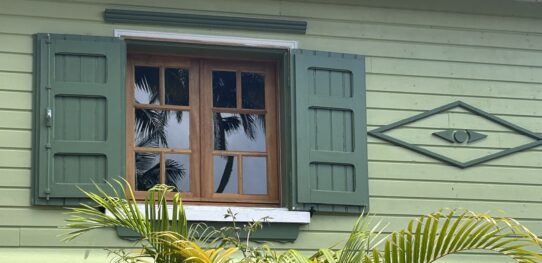 ▲ and some more.
▲ and some more.
Saint-Denis is the capital and Rue de Paris seems to stretch forever from the Jardins de L’Etat with the Musee d’Histoire Naturelle down to the waterfront. Along the way you pass one impressive Creole Villa after another.
 ▲ like the Villa-du-Département
▲ like the Villa-du-Département
 ▲ some beautifully restored like the Léon Dierx Museum
▲ some beautifully restored like the Léon Dierx Museum
 ▲ or the Villa de la Region
▲ or the Villa de la Region

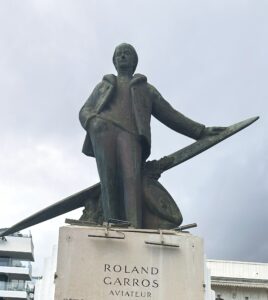 ▲ others overdue for some love and attention, like the Maison Timol
▲ others overdue for some love and attention, like the Maison Timol
Down at the waterfront, having passed the Hôtel de Ville with the Monument aux morts de La première Guerre Mondiale column, also known as La colonne de La Victoire in the centre of the crossroads, then the yellow Ancien Hôtel de Ville and the big Préfecture facing towards the waterfront, you’ll come to a fusillade of cannons facing out to sea and the Statue of Roland Garros.
◄ Statue Roland Garros, Saint-Denis
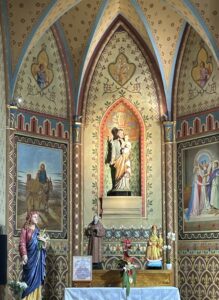 You will already have met Monsieur Garros at the Réunion airport, it’s named after him. And of course it’s the title of the French tennis open. He appears here because the pioneer French aviator – he was shot down and died in 1918 during WW I – was born in Saint-Denis.
You will already have met Monsieur Garros at the Réunion airport, it’s named after him. And of course it’s the title of the French tennis open. He appears here because the pioneer French aviator – he was shot down and died in 1918 during WW I – was born in Saint-Denis.
◄ Notre-Dame de la Délivrance Church, St-Denis – cross the river and climb up the hill to the church, impressively colourful from the outside but even more decorative inside. It’s worth the walk, then cross back towards the centre and on the other side of Rue de Paris is the not so impressive Cathedrale de Saint-Denis.
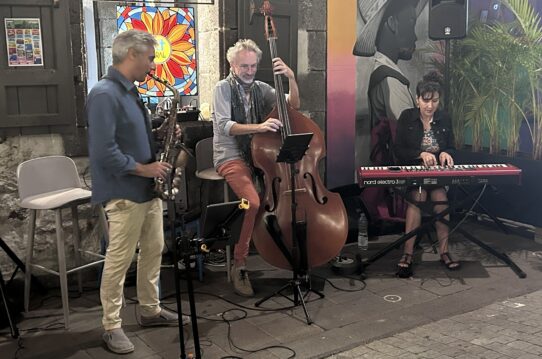
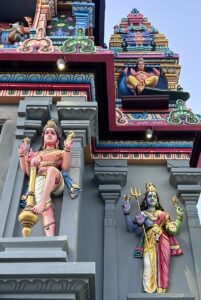 ▲ Musicians (sax, upright bass, keyboard) performing outside Kt DRAX
▲ Musicians (sax, upright bass, keyboard) performing outside Kt DRAX
There’s a crowd of restaurants and bars, particularly bars, right beside and behind the Cathedral. On my last night in Saint-Denis I had dinner at Kt DRAX – they’d run out of gazpacho, but I had côte de bœuf, a Fischer beer, ice cream and a glass of red for €41.90. Very Parisian. I stayed at the Dina Morgabine in Saint-Denis, comfortable and well equipped, close to the waterfront and also featuring an excellent restaurant and bar.
◄ Just to prove it’s not all Christian there’s the colourful Hindu Kalikambal Temple plus the Noor-e-Islam Mosque and the unimpressive Chinese Temples Chane and Temples Lisi Tong.
 ▲ Formica Leo Crater inside the Piton de la Fournaise volcano crater
▲ Formica Leo Crater inside the Piton de la Fournaise volcano crater
The south of the island is dominated by the huge – and periodically active – Piton de la Fournaise (Peak of the Furnace) volcano crater. It’s recommended that you get to the Pas de Bellecombe car park, where the road ends and you start walking, as soon after dawn as possible. There’s a drab (and not very welcoming) little café at the car park, stock up, it’s quite likely to be closed when you get back from your crater walk. From Pas de Bellecombe you walk along the crater edge towards the Gîte du Volcan, where you can stay the night if you plan ahead. Then you descend far too many steps down to the crater floor from where it’s only a short distance to the smaller Formica Leo Crater, inside the main crater.
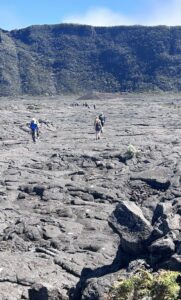 ◄ From Formica Leo it’s a long walk across the crater floor to the climb up the other side of the main crater, which you then follow along the crater rim to the dramatic Dolomieu Crater. And then back again, the total distance is about 11km, say 2-1/2 to three hours in each direction. So it’s quite a distance and right at the end, having passed by the Formica Leo Crater again, you’ve got all those steps to climb to get back to the crater edge and the Pas de Bellecombe car park. Lots of people clearly find that final climb very hard work!
◄ From Formica Leo it’s a long walk across the crater floor to the climb up the other side of the main crater, which you then follow along the crater rim to the dramatic Dolomieu Crater. And then back again, the total distance is about 11km, say 2-1/2 to three hours in each direction. So it’s quite a distance and right at the end, having passed by the Formica Leo Crater again, you’ve got all those steps to climb to get back to the crater edge and the Pas de Bellecombe car park. Lots of people clearly find that final climb very hard work!

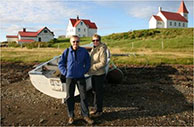
 ▲ Drive east and then south from Saint-Denis, the capital and turn inland towards Salazie and you’re soon climbing a gorge into the central highlands, passing a regular cascade of waterfalls, particularly if it has been raining.
▲ Drive east and then south from Saint-Denis, the capital and turn inland towards Salazie and you’re soon climbing a gorge into the central highlands, passing a regular cascade of waterfalls, particularly if it has been raining. ▲ The Salazie Town Hall (Hotel de Ville) is a fine example of the Creole architecture Réunion is noted for.
▲ The Salazie Town Hall (Hotel de Ville) is a fine example of the Creole architecture Réunion is noted for. ▲ Hell-Bourg – continue uphill and you’ll arrive at Hell-Bourg, ‘one of the most beautiful villages in France’ according to the Lonely Planet Mauritius, Réunion & Seychelles guidebook. That’s a big claim, but there are certainly some very pretty Creole cottages in the village.
▲ Hell-Bourg – continue uphill and you’ll arrive at Hell-Bourg, ‘one of the most beautiful villages in France’ according to the Lonely Planet Mauritius, Réunion & Seychelles guidebook. That’s a big claim, but there are certainly some very pretty Creole cottages in the village. ▲ and some more.
▲ and some more. ▲ like the Villa-du-Département
▲ like the Villa-du-Département ▲ some beautifully restored like the Léon Dierx Museum
▲ some beautifully restored like the Léon Dierx Museum ▲ or the Villa de la Region
▲ or the Villa de la Region
 ▲ others overdue for some love and attention, like the Maison Timol
▲ others overdue for some love and attention, like the Maison Timol You will already have met Monsieur Garros at the Réunion airport, it’s named after him. And of course it’s the title of the French tennis open. He appears here because the pioneer French aviator – he was shot down and died in 1918 during WW I – was born in Saint-Denis.
You will already have met Monsieur Garros at the Réunion airport, it’s named after him. And of course it’s the title of the French tennis open. He appears here because the pioneer French aviator – he was shot down and died in 1918 during WW I – was born in Saint-Denis.
 ▲ Musicians (sax, upright bass, keyboard) performing outside Kt DRAX
▲ Musicians (sax, upright bass, keyboard) performing outside Kt DRAX ▲ Formica Leo Crater inside the Piton de la Fournaise volcano crater
▲ Formica Leo Crater inside the Piton de la Fournaise volcano crater ◄ From Formica Leo it’s a long walk across the crater floor to the climb up the other side of the main crater, which you then follow along the crater rim to the dramatic Dolomieu Crater. And then back again, the total distance is about 11km, say 2-1/2 to three hours in each direction. So it’s quite a distance and right at the end, having passed by the Formica Leo Crater again, you’ve got all those steps to climb to get back to the crater edge and the Pas de Bellecombe car park. Lots of people clearly find that final climb very hard work!
◄ From Formica Leo it’s a long walk across the crater floor to the climb up the other side of the main crater, which you then follow along the crater rim to the dramatic Dolomieu Crater. And then back again, the total distance is about 11km, say 2-1/2 to three hours in each direction. So it’s quite a distance and right at the end, having passed by the Formica Leo Crater again, you’ve got all those steps to climb to get back to the crater edge and the Pas de Bellecombe car park. Lots of people clearly find that final climb very hard work!
